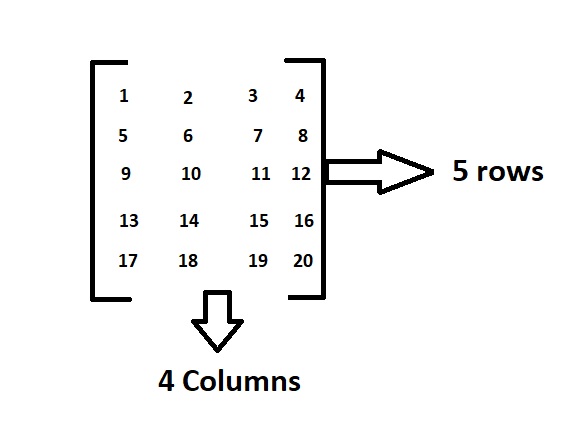In the previous article, we have discussed Python Program for Frequencies of Even and Odd Numbers in a Matrix
Given a square matrix, the task is to swap the upper diagonal elements and lower diagonal elements of a given matrix.
What is a matrix:
A matrix is a rectangular sequence of numbers divided into columns and rows. A matrix element or entry is a number that appears in a matrix.
Diagonal Matrix:
The entries outside the main diagonal of a diagonal matrix are all 0; the word usually refers to square matrices.
Example:

Above is the matrix which contains 5 rows and 4 columns and having elements from 1 to 20.
In this order, the dimensions of a matrix indicate the number of rows and columns.
Here as there are 5 rows and 4 columns it is called a 5*4 matrix.
Examples:
Example1:
Input:
Given Matrix : 10 20 30 45 60 70 11 12 13
Output:
The Matrix after swapping the upper diagonal and lower diagonal elements is: 10 45 11 20 60 12 30 70 13
Example2:
Input:
Given Matrix : 3 5 1 4 2 0 2 6 4
Output:
The Matrix after swapping the upper diagonal and lower diagonal elements is: 3 4 2 5 2 6 1 0 4
Program to Swap Upper Diagonal Elements with Lower Diagonal Elements of Matrix in Python
Below are the ways to swap the upper diagonal elements and lower diagonal elements of a given matrix in python:
Method #1: Using For Loop (Static Input)
Approach:
- Give the matrix as static input and store it in a variable.
- Calculate the number of rows of the given matrix by calculating the length of the nested list using the len() function and store it in a variable mtrxrows.
- Calculate the number of columns of the given matrix by calculating the length of the first list in the nested list using the len() function and store it in a variable mtrxcolums.
- Loop till the given number of rows using the For loop.
- Inside the For loop, iterate from the iterator value +1 of the parent for loop to the given number of rows using another Nested For loop(Inner For loop).
- Swap mtrx[itor][k], mtrx[k][itor] using the comma(,) operator ( where itor is the iterator value of the parent for loop and k is the iterator value of the inner for loop).
- Loop till the given number of rows using the For loop.
- Inside the For loop, Iterate till the given number of rows using another Nested For loop(Inner For loop).
- Print the element of the matrix by printing gvnmatrix[n][m] value where n is the iterator value of the parent For loop and m is the iterator value of the inner For loop.
- The Exit of the Program.
Below is the implementation:
# Give the matrix as static input and store it in a variable.
mtrx = [[10, 20, 30], [45, 60, 70], [11, 12, 13]]
# Calculate the number of rows of the given matrix by
# calculating the length of the nested list using the len() function
# and store it in a variable mtrxrows.
mtrxrows = len(mtrx)
# Calculate the number of columns of the given matrix by
# calculating the length of the first list in the nested list
# using the len() function and store it in a variable mtrxcols.
mtrxcols = len(mtrx[0])
# Loop till the given number of rows using the For loop.
for itor in range(0, mtrxrows):
# Inside the For loop, iterate from the iterator value +1 of the parent for loop to the
# given number of rows using another Nested For loop(Inner For loop).
for k in range(itor + 1, mtrxrows):
# Swap mtrx[itor][k], mtrx[k][itor] using the comma(,) operator ( where itor is the
# iterator value of the parent for loop and k is the iterator value
# of the inner for loop).
mtrx[itor][k], mtrx[k][itor] = mtrx[k][itor], mtrx[itor][k]
print("The Matrix after swapping the upper diagonal and lower diagonal elements is:")
# Loop till the given number of rows using the For loop.
for n in range(mtrxrows):
# Inside the For loop, Iterate till the given number of rows using another
# Nested For loop(Inner For loop).
for m in range(mtrxcols):
# Print the element of the matrix by printing gvnmatrix[n][m] value
# where n is the iterator value of the parent For loop and m is the iterator
# value of the inner For loop.
print(mtrx[n][m], end=' ')
print()
Output:
The Matrix after swapping the upper diagonal and lower diagonal elements is: 10 45 11 20 60 12 30 70 13
Method #2: Using For loop (User Input)
Approach:
- Give the number of rows of the matrix as user input using the int(input()) function and store it in a variable.
- Give the number of columns of the matrix as user input using the int(input()) function and store it in another variable.
- Take a list and initialize it with an empty value using [] or list() to say gvnmatrix.
- Loop till the given number of rows using the For loop
- Inside the For loop, Give all the row elements of the given Matrix as a list using the list(),map(),int(),split() functions and store it in a variable.
- Add the above row elements list to gvnmatrix using the append() function.
- Loop till the given number of rows using the For loop.
- Inside the For loop, iterate from the iterator value +1 of the parent for loop to the given number of rows using another Nested For loop(Inner For loop).
- Swap mtrx[itor][k], mtrx[k][itor] using the comma(,) operator ( where itor is the iterator value of the parent for loop and k is the iterator value of the inner for loop).
- Loop till the given number of rows using the For loop.
- Inside the For loop, Iterate till the given number of rows using another Nested For loop(Inner For loop).
- Print the element of the matrix by printing gvnmatrix[n][m] value where n is the iterator value of the parent For loop and m is the iterator value of the inner For loop.
- The Exit of the Program.
Below is the implementation:
# Give the number of rows of the matrix as user input using the int(input()) function
# and store it in a variable.
mtrxrows = int(input('Enter some random number of rows of the matrix = '))
# Give the number of columns of the matrix as user input using the int(input()) function
# and store it in another variable.
mtrxcols = int(input('Enter some random number of columns of the matrix = '))
# Take a list and initialize it with an empty value using [] or list() to say gvnmatrix.
mtrx = []
# Loop till the given number of rows using the For loop
for n in range(mtrxrows):
# Inside the For loop, Give all the row elements of the given Matrix as a list using
# the list(),map(),int(),split() functions and store it in a variable.
l = list(map(int, input(
'Enter {'+str(mtrxcols)+'} elements of row {'+str(n+1)+'} separated by spaces = ').split()))
# Add the above row elements list to gvnmatrix using the append() function.
mtrx.append(l)
# Loop till the given number of rows using the For loop.
for itor in range(0, mtrxrows):
# Inside the For loop, iterate from the iterator value +1 of the parent for loop to the
# given number of rows using another Nested For loop(Inner For loop).
for k in range(itor + 1, mtrxrows):
# Swap mtrx[itor][k], mtrx[k][itor] using the comma(,) operator ( where itor is the
# iterator value of the parent for loop and k is the iterator value
# of the inner for loop).
mtrx[itor][k], mtrx[k][itor] = mtrx[k][itor], mtrx[itor][k]
print("The Matrix after swapping the upper diagonal and lower diagonal elements is:")
# Loop till the given number of rows using the For loop.
for n in range(mtrxrows):
# Inside the For loop, Iterate till the given number of rows using another
# Nested For loop(Inner For loop).
for m in range(mtrxcols):
# Print the element of the matrix by printing gvnmatrix[n][m] value
# where n is the iterator value of the parent For loop and m is the iterator
# value of the inner For loop.
print(mtrx[n][m], end=' ')
print()
Output:
Enter some random number of rows of the matrix = 3
Enter some random number of columns of the matrix = 3
Enter {3} elements of row {1} separated by spaces = 3 5 1
Enter {3} elements of row {2} separated by spaces = 4 2 0
Enter {3} elements of row {3} separated by spaces = 2 6 4
The Matrix after swapping the upper diagonal and lower diagonal elements is:
3 4 2
5 2 6
1 0 4Find the best practical and ready-to-use Python Programming Examples that you can simply run on a variety of platforms and never stop learning.
